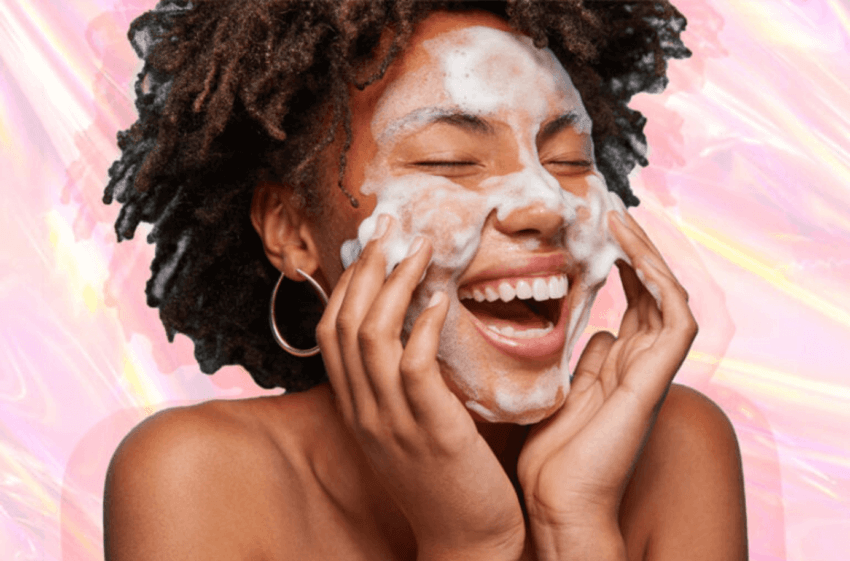Dermaplaning Is The Terrifying Skin Ritual That Gives INSANE Results
 via Giphy
via Giphy
While we’re down to try anything in the name of beauty, we were slightly hesitant when it came to dermaplaning. Then we heard about the benefits of this scary AF skin ritual, and we were ready to overcome our fears… Anything to get that glow, right? If this is the first you’ve heard of dermaplaning, it’s a form of exfoliation where an aesthetician uses a scalpel to remove dead skin and peach fuzz. The result? Brighter, more radiant skin that’ll last for A MONTH. For the 411, we spoke to Managing Esthetician at the luxury Skin Spa New York, Elena Tsiaklis. Here’s everything you need to know about dermaplaning:
What is Dermaplaning?
Dermaplanning is an in-clinic treatment where a doctor or aesthetician uses a scalpel-like blade to remove the dead skin that sits on the surface of your skin and makes it appear dull and congested. It’ll also “shave” off any peach fuzz, leaving you with a more radiant, smoother complexion. The process is pain-free and will normally take 20 to 30 minutes. It’ll typically be combined with another skincare treatment, usually something hydrating and nourishing.
View this post on Instagram
The Benefits of Dermaplaning (hint: there’s a lot)
If you need a little more convincing to allow a stranger to approach your face with a knife, get ready to be won over. Elena explains “Dermaplaning is a safe and effective physical form of exfoliation. It eliminates vellus hair and dead skin cells, increases product absorption and efficacy. It promotes skin cell turnover, minimizes fine lines and wrinkles, lessens acne occurrence, brightens skin, and reduces hyperpigmentation. It also helps makeup application look smooth and flawless.” In short “Dermaplaning removes up to 21 days of dead skin cells and the results last up to four weeks.” We’ve got to say, that’s a pretty solid sales pitch!
Although Elena states that “Dermaplaning’s safe and effective for most skin types” it can cause irritation if the client has “active acne or extremely sensitive skin. It should also be avoided by clients with open wounds, raised lesions or if they have an allergy to nickel or have used Accutane within six months.” Similarly, it can be a little more difficult with very oily skin as the blade can snag a little.
The Dermaplaning Treatment
The consultation: Elena says “If you’re thinking about having a dermaplaning treatment, a consultation is a great idea. The esthetician can evaluate your skin and assess if you are a candidate or if another treatment would be more beneficial.”
Posts You'll Love:
How to Prep for Dermaplaning
To maximize the benefits and avoid any irritation, make sure you prep your skin using Elena’s following guidelines:
Stop exfoliating: “To ensure the skin is not damaged by over-exfoliation, discontinue all exfoliants, including AHAs, BHAs, enzymes, micro-beads, and retinoids for five to seven days.”
Skip the retinol and the sunbathing: “If you’re currently using Retin-A, discontinue use for seven to fourteen days prior to the treatment. You should also avoid sun exposure for five to seven days prior to ensure you do not have a sunburn.”
Let your hair grow: “Hair removal such as waxing, threading, and shaving should be avoided for at least two weeks before dermaplaning.”
If you breakout… “In the event of active acne and raised lesions on the day of treatment, it’s best to reschedule until the skin is fully healed. There is also a six-month waiting period upon completion of Accutane.”
What to Do After Dermplaning
Elena warns that you should “Avoid direct contact with the sun for the first 48 to 72 hours and always wear a broad-spectrum sunscreen. Discontinue use of any exfoliating agents for one week and use a gentle cleanser. But by all means, take advantage of the better product absorption and use high-grade serums and moisturizers!”
Dermaplaning Vs Shaving
A lot of people (understandably) think that dermaplaning is simply an in-clinic version of face shaving. Elena sets the record straight: “A razor you get from the drugstore won’t be as sharp or as effective as a medical-grade scalpel.” Explaining “Facial shaving randomly removes some skin cells in an inconsistent manner. Dermaplaning’s a refined and careful approach to removing skin cells and vellus hair. Also, there’s always the chance you will cut yourself in the process which is why it is better left to a professional.” However, if you do want to shave your face at home, make sure you follow our at-home face-shaving guide to do it safely!























Leave a comment